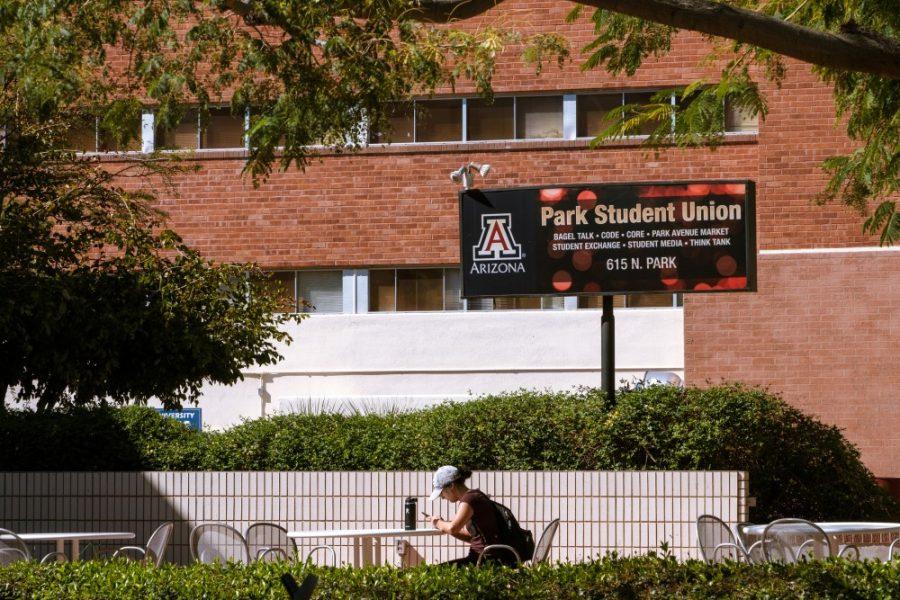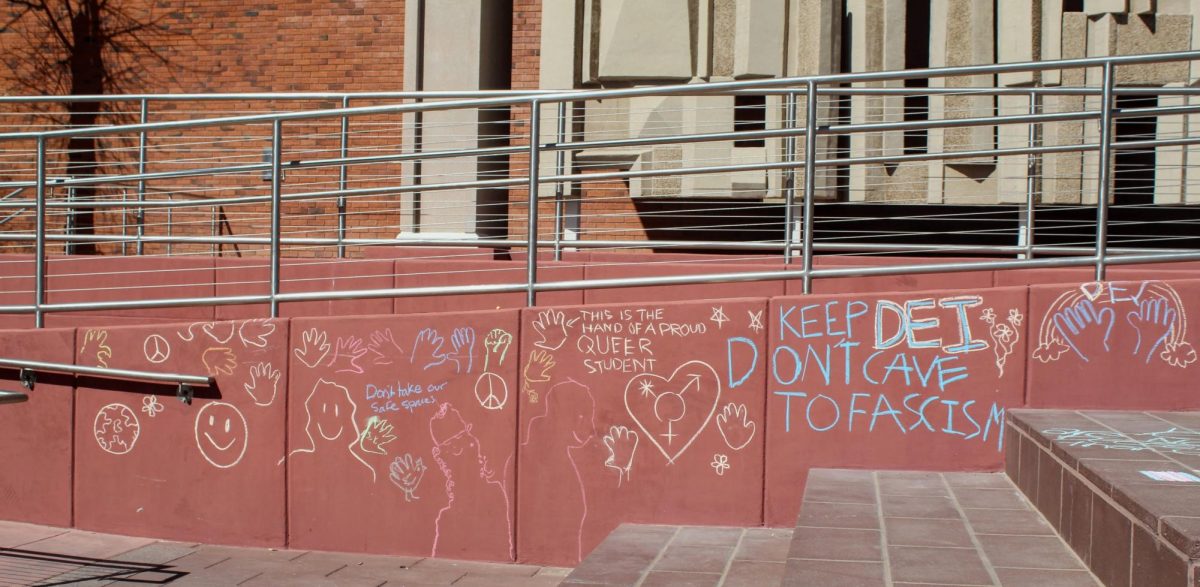This story has been updated to reflect an April 11 meeting between Jeffrey Goldberg, interim senior vice president for Academic Affairs and provost, Brent White, vice provost for Global Affairs, and Arizona Student Media.
A previous Daily Wildcat story reported a new UA Global Center will move into the current Park Student Union building, displacing several business, including Arizona Student Media. According to the student leaders of KAMP Student Radio, UATV and the Daily Wildcat, moving is not really a problem, but the lack of communication and lack of student involvement in the plan is.
“Nobody at the Daily Wildcat is saying, ‘This is complete crap, we have to move out of this space because these students or UA Global doesn’t deserve it.’ That’s not what we’re saying at all,” said Jasmine Demers, editor-in-chief of the Daily Wildcat. “UA Global has created a plan that is very admirable. We want our global students to be able to have a space to go to … But the fact that we are being pushed out of our space with no acknowledgement is very disappointing, and the fact that this strategic plan is supposedly so focused on students … nobody came to the student leaders of Arizona Student Media.”
RELATED: Park Student Union to become UA Global Center
KAMP Radio General Manager Robby Leaño said the lack of communication is an issue, as student media is important to a large part of the campus community.
“I really wish we would have a lot more communication about this in the first place. Student media means the world to all of us,” Leaño said. “It means the world to me. I joined KAMP literally my first day on campus.”
Olivia Jackson, general manager of UATV, pointed out that, when covering the University, Arizona Student Media makes sure to communicate with the UA, but said she felt that had not been reciprocated.
“There are things that they’re doing that are good, and when they’re doing something that isn’t so good, we still reach out to them so they can have their comment, so we can also write their side,” Jackson said. “They just ignored our side.”
For Leaño, the situation is “frustrating,” especially considering KAMP Radio moved locations into the same building as UATV and the Daily Wildcat just last year. The move was to foster collaboration and save on operating costs.
“We were at that previous location for 12 years plus, and to have to take everything down, throw some things away that we can’t keep, abandon some of the culture we had, it was frustrating for a lot of people,” Leaño said. “But it was a new opportunity. We thought, okay, we’re going to be here for a couple years … to have to move again within a year makes it even more frustrating.”
Brett Fera, director of Arizona Student Media, said the cost of the renovations to create broadcast and recording booths was about $32,000.
“We spent the money to move the radio station, and it was many, many thousands of dollars because of soundproofing radio booths and rewiring and physical move. That money is down the drain, because we now have to go move as a department somewhere else,” Fera said.
RELATED: UA unveils new, far-reaching strategic plan
Leaño said while the move was stressful at first, the new space is ideal for the station and has increased production. He said he hopes the space student media ends up in is similar, from a technological standpoint, though he is concerned about further loss of KAMP Radio culture.
“I’m going to assume that all of us are going to share the same space … It’s going to be a little more quiet than we usually have it. We usually like to have fun out here, because we’re in a slightly more isolated area. We can put music up and goof around,” Leaño said. “I know the Wildcat and UATV, they like to have their fun, but they’re much more professional than KAMP is. So it puts more limitations on what we can do.”
The current space Arizona Student Media occupies was designed with input from students and staff in 2001, Fera said. As a result, Arizona Student Media does not pay rent to the University, according to Fera, but debt service on 24 percent of the loans taken out for the renovations. So far, Arizona Student Media has paid about $1.2 million of approximately $2.3 million in loans.
“That building was designed for us as student media, was essentially paid for by student media, with a lot of those funds coming from donors that were specific to support student media,” Fera said.
Tied to some of those funds were named spaces. The newsroom is called the Sherman R. Miller III Newsroom, after a past Daily Wildcat advisor, and the George B. Morely II and Charley Kennedy Business Development Center is also in the space. Fera said this makes moving more complex.
Aside from the need to retain named spaces, Arizona Student Media has other specific needs, Demers said, including proximity to the center of campus and the UA School of Journalism to be able to cover events and a space large enough to fit three media operations.
“If we have a space that’s smaller than we have now, with three major student media organizations in one building … we’re definitely going to lose people. There’s no doubt about that,” Demers said.
Fera also pointed to the necessity of equal technological capabilities in the future space.
“We’ve been shown a couple of places, and there are people working on our behalf to find us space, and the problem in two of the cases, technology is a very, very tough sled on those locations,” Fera said. “We have to really be cognizant that we can’t all of a sudden move a department that is transferring tons of video and tons of high-res images and everything else that goes into producing media to an area that can’t get fast internet.”
Demers said she delivered a letter outlining Arizona Student Media’s concerns to UA President Dr. Robert Robbins on Wednesday, April 3. The letter was signed by over 60 staff members. The UA issued an official response to concerns raised in the letter on April 5, writing the UA is “committed to finding a permanent home for Arizona Student Media that is appropriate for the vital services our student journalists provide” and “working collaboratively to find a solution that meets the needs of the students and staff of Arizona Student Media.”
The letter, signed by Jeffrey Goldberg, interim senior vice president for Academic Affairs and provost; Kendal Washington White, vice provost for Campus Life and dean of students and Brent White, vice provost for Global Affairs on behalf of Robbins, also said they “welcome input from the UA community, particularly from students and alumni of Arizona Student Media.”
On April 11, Goldberg and White met with the Daily Wildcat editorial board and Leaño to discuss their concerns. Goldberg and White reiterated their commitment to ensure Arizona Student Media moves into a equitable space and gets the necessary support from the UA. They also talked with the students about what their specific needs would be for a future space.
Moving forward, Demers said she would like for herself and other student leaders to continue to be included in the conversations and to be supported by the UA.
“The Daily Wildcat is a 120-year-old institution. We, along with the other student media outlets, UATV and KAMP, provide not only information to our campus community but representation,” Demers said. “We are here, as all press is, to make sure that people within the community feel that they are represented … We know how much value we bring to the university and to our community, and we’ll do anything to continue doing that. But it would be really nice if we had more support.”
RELATED: EDITORIAL: Joining the call to #SaveStudentNewsrooms
Fera said while the uncertainty is stressful for all involved, he is positive Arizona Student Media will land on its feet and continue to serve the community.
“I am confident that the university is not just going to set a date and say, ‘be out of here,’” Fera said. “There’s going to be a solution, I just have no idea what that solution is going to be at this point.”
Follow Marissa Heffernan on Twitter









